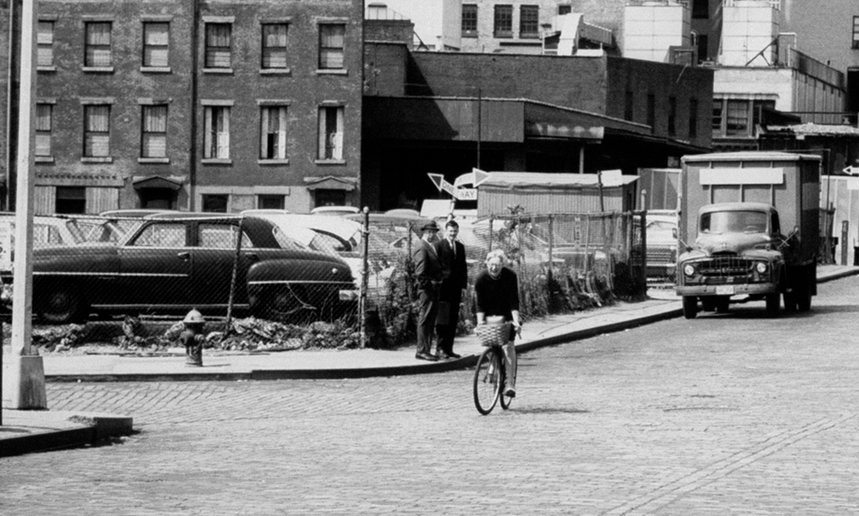
famous battles against redevelopment.
Pictures/Getty
i first met Jane Jacobs in
the early 90s. She was sitting in the front row of a large Toronto auditorium
as I delivered a one-hour lecture. I did not know who she was.
When
I was done, the first hand up – sharply so – belonged to this elderly person.
How wonderful, I thought, a citizen who has never stopped being engaged. What
came out of her mouth, though, was one of the sharpest critiques of my way of
analysing the city that I’d ever heard – and probably ever will.
She
pursued a line of questioning quite different from what I usually get. She
continously returned to the issue of “place”, and its importance when
considering the implementation of urban policies – notably the loss of
neighbourhoods and erasure of local residents’ experiences. Her input made me
shift my thinking to more “micro” levels; I am still doing quite a bit of work
today on the need to relocalise pieces of national and city economies.
So
perhaps now, on the 100th anniversary of her birth, we should all be asking:
what is it that Jane Jacobs made us want to see in the city?
Thinking
about this question leads me to focus on the conditions that make a metropolis
– the enormous diversity of workers, their living and work spaces, the multiple
sub-economies involved. Many of these are now seen as irrelevant to the global
city, or belonging to another era. But a close look, as encouraged by Jacobs,
shows us this is wrong.
She would ask us to look at the consequences of these
sub-economies for the city – for its people, its neighbourhoods, and the visual
orders involved. She would ask us to consider all the other economies and
spaces impacted by the massive gentrifications of the modern city – not least,
the resultant displacements of modest households and profit-making,
neighbourhood firms.
How do we see those aspects
that are typically rendered invisible by modern narratives of development and
urban competitiveness? In the early 1900s, the city was a lens for
understanding larger processes – but half a century later, it had lost that
role. It was Jane Jacobs who taught us again to view the city in a deeper, more
complex way.
She
helped us re-emphasise dimensions that were usually excluded – no, expelled –
from general analyses of the urban economy. Indeed, I can imagine she would
have affirmed without a quiver of doubt that, no matter how electronic and
global the city might one day become, it still has to be “made” – and therein
lies the importance of place.
The
city has long been a strategic site for the exploration of major subjects
confronting society. In the first half of the 20th century, the study of cities
was at the heart of sociology–
evident in the work of Simmel, Weber, Benjamin, Lefebvre and the Chicago School. These sociologists confronted
massive processes: industrialisation, urbanisation, alienation, and a new cultural
formation they called “urbanity”. Studying the city meant studying the major
social processes of an era.
But
by the 1950s, the study of the city had gradually lost this privileged role as
producer of key analytic categories. The social sciences, we might say, lost
their capacity to “see” the city and all that it made visible. But not Jacobs.
For
her, the barricades – both figurative and literal – played a role not merely as
part of the battle to preserve
one of the oldest parts of Manhattan, but in her entire analysis of the
urban economy. Jacobs’ passionate fight to protect “the Village” in Lower
Manhattan was about much more than preserving an old urban landscape (though
this in itself was enough to warrant a fight in a city like New York – where
the developers ruled, and basically did not care about legacy or visual
orders).
Talking with Jacobs, it
became clear that community battles were, for her, simply part of a wider
inquiry as she sought to better understand, and develop concepts for, the role
of cities in the economy. Richard Sennett, who was often on the “picket
lines” with Jacobs, talks of her calm ferocity; she was relentless, and stood
up to anyone – no matter her smallish frame and, eventually, her elderly
condition.
Why
is it so important to recover the sense of place, and production, in our
analyses of the global economy, particularly as these are constituted in major
cities? Because they allow us to see the multiplicity of economies and working
cultures in which regional, national and global economies are embedded.
But
Jacobs went much further than this. What she showed us, crucially, is that urban space is the key building block of these economies. She understood it
is the weaving of multiple strands that makes the city so much more than the
sum of its residents, or its grand buildings, or its corporate economy.